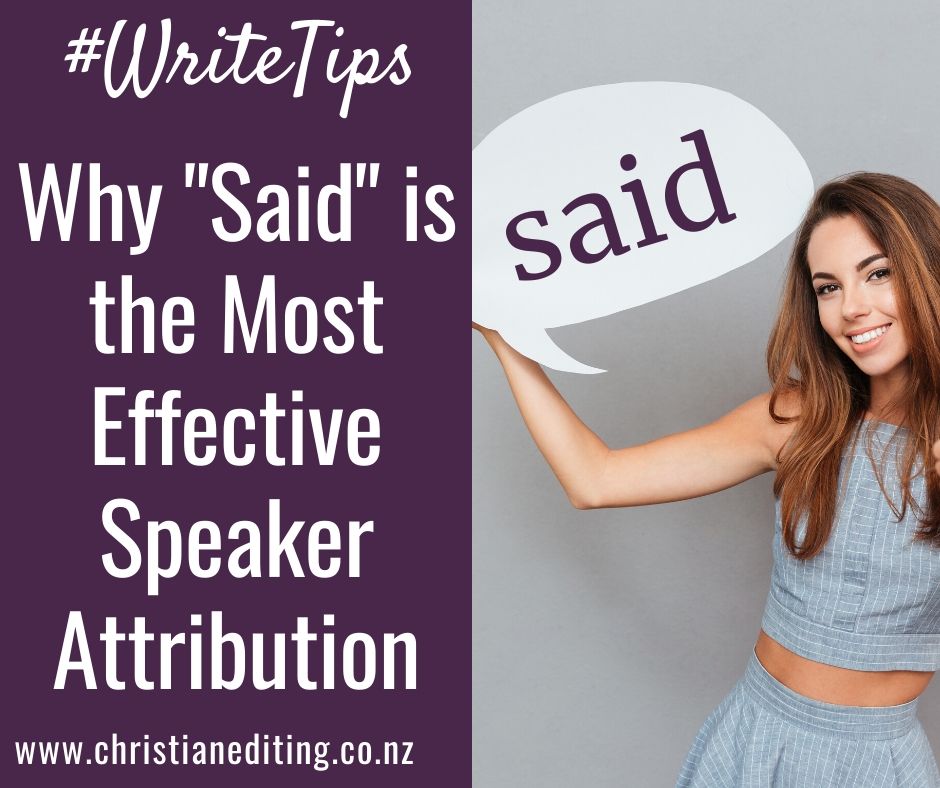Last week, I discussed why “said” is the most effective speaker attribution. No, I’m not a fan of creative dialogue tags (she apologised unrepentantly).
But using “said” all the time can get boring and repetitive, and we don’t want our fiction to be boring or repetitive. What can we do?
Fortunately, there are several alternatives to said. These include:
- Action beats
- Dialogue cues
- Interior monologue
Today I’m going to discuss action beats, and suggest three tips for writing strong action beats.
Action Beats
Action beats are used in fiction to break up the dialogue and Browne and King define action beats as:
The bits of action interspersed throughout a scene, such as a character walking to a window … Usually they involve physical gestures.
The advantage of using an action beat over a speaker attribution is that the action beat serves multiple purposes:
- It breaks up the dialogue.
- It tells the reader who is speaking.
- It shows the reader something about the scene.
- It provides a sense of progression and movement.
- It also gets away from the perceived problem of overusing the boring “said”.
An action beat is visible, so it can be an action performed by the point of view character (when the point of view character is the speaker), or observed by the point of view character (when the point of view character isn’t the speaker).
There are three common problems with using action beats as dialogue tags:
- Combining speaker attributions and action beats.
- Using boring action beats.
- Using too many action beats.
Combining Speaker Attributions and Action Beats
There is no need for a speaker attribution if you’re also using an action beat, because the action beat fulfils the role of the speaker attribution. For example:
“I’m sorry,” Jane said, and looked at the floor.
Becomes:
“I’m sorry.” Jane looked at the floor.
Cutting the speaker attribution will tighten the writing and improve the pace.
Using Boring Action Beats
An action beat is your opportunity to show what is happening. But many authors use the same action beats over and over, to the point when they become boring. For example:
- Jack blinked.
- Jack nodded.
- Jack shrugged.
- Jack smiled.
It’s not that there is anything wrong with any of these beats. The issue is they tend to be overused—one original smile shows something about the character. One hundred smiles shows nothing. The trick is to take the plain “she smiled” and expand it to a more powerful smile, one that shows the reader more about the character.
There was nothing happy about Jack’s smile. It was more Hannibal Lecter meets The Joker.
Or:
Jack smiled a slow smile, a smile that said he had all the time in the world and nowhere else he’d rather be.
The right smile (or nod or shrug or blink) will obviously depend on your character and the specific scene. Play around with your actions, and see how you can strengthen your action beats. If you can’t strengthen them, can you use a speaker attribution, a line of interior monologue, or a dialogue cue instead?
Sometimes authors take these boring but functional action beats and turn them into telling:
- Jack blinked in confusion.
- Jack nodded in agreement.
- Jack shrugged indecisively.
Why are these telling? Because they are not visual, or because they are predictable. What does a confused blink look like? When do we nod except in agreement? Again, use your imagination to see how you can strengthen your action beats and use them to deepen character and move the plot forward.
Jack blinked long and slow, so long and slow she could have fallen asleep between one blink and the next.
Or:
Jack blinked twice and his left eye crinkled at the corner. Jane was sure he had no idea what she was talking about. Typical.
Or perhaps Jack doesn’t blink at all (and perhaps he’s not confused):
Jack looked left, right, up, down. Anywhere but at her. Either he had no idea what she was talking about, or he was trying to dream up a convincing lie. He looked up and left again, his usual tell when he was trying to come up with a creative yet convincing response. That look said he was guilty. Big surprise. Not.
Boring action beats make excellent placeholders in you first draft, because they don’t require any thought. But ensure that you revise the boring beats into something fresh when you edit. Use action beats, interior monologue, or dialogue cues to better show the action and emotion.
Even better, use body language to show the emotion—what’s going on behind the scene. The following resources will help you come up with fresh action beats to better show emotion:
- The Emotion Thesaurus by Angela Ackerman and Becca Puglasi
- Writing Body Language and Dialogue Cues by Margie Lawson (which can be purchased as an online course or as a lecture packet).
Using Too Many Action Beats
Some authors pepper their dialogue with action beats, to the point where the dialogue becomes a ping-pong match. Remember, the purpose of the action beat is to identify who is speaking and make the scene visible.
For example:
“Hi.” Jake lifted a hand in greeting. “How are you?” He put his hand in his pocket. “I haven’t seen you around for a while.” He looked away, unable to meet my eyes. Was he embarrassed?
For example:
“Hi.” Jake lifted a hand in greeting. “How are you?” He put his hand in his pocket. “I haven’t seen you around for a while.” He looked away, unable to meet my eyes. Was he embarrassed?
Instead, pare back the action beats to focus on what’s important:
“Hi, Jane. How are you?” Jake looked past me, unable to meet my eyes. “I haven’t seen you around in a while.”
As James Scott Bell points out:
Too many action tags will wear the reader out. Variety is called for, and often the best choice is no tag at all.
So ensure your action beats add to the scene, rather than taking away from it.
I’ll be back next week to discuss two more alternatives to “said”—interior monologue, and dialogue cues.



